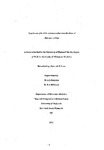Genetic analysis of the microvascular complications of diabetes mellitus
| dc.contributor.author | Cross, Deborah F | |
| dc.contributor.other | Faculty of Health | en_US |
| dc.date.accessioned | 2013-10-23T10:49:56Z | |
| dc.date.available | 2013-10-23T10:49:56Z | |
| dc.date.issued | 2002 | |
| dc.identifier | NOT AVAILABLE | en_US |
| dc.identifier.uri | http://hdl.handle.net/10026.1/2316 | |
| dc.description.abstract |
There is increasing evidence to suggest that genetic factors are involved in the pathogenesis of microvascular complications in diabetes mellitus. Recent studies have suggested that genetic variations in the aldose reductase (ALR2) gene may contribute to the genetic susceptibility to microvascular complications. Aldose reductase is the first and rate-limiting enzyme of the polyol pathway and is implicated in the pathogenesis of diabetic microvascular disease (nephropathy, retinopathy and neuropathy). It has recently been shown that the three polymorphisms of the ALR2 gene are associated with susceptibility to microvascular complications in both TIDM and T2DM. The aim of this study was to investigate the CA dinucleotide repeat polymorphism (5'ALR2) that is located -2100bp and the C-106T substitution in the promoter region of the ALR2 gene, and also the A+ 11842C within intron 8 of the ALR2 gene itself. DNA from 285 Caucasoid patients with TIDM and well-defined microvascular disease and 120 normal healthy controls, as well as 60 Southern Indian patients with T2DM and 43 non diabetic controls were typed. The 5'ALR2 Z-2/X genotype was significantly increased in patients with nephropathy (n=92), retinopathy (n=160) and neuropathy (n=104) compared to those with no microvascular disease after 19 years duration of diabetes (uncomplicated, n=66) (46%, 41%, 42% vs. 24%, respectively). In contrast, the frequency of the Z+2/Y genotype (where Y is not Z-2) was significantly reduced in the patients with nephropathy, retinopathy and neuropathy compared to the uncomplicated (17%, 23%, 23% vs. 52%, respectively). Similar observations were made in the Southern Indian T2DM patients, however no significant differences were found. In the patients with TIDM the C-106 allele was associated with the Z-2 5'ALR2 allele. The C/Z-2 haplotype was present in 32% of the nephropaths, 32% of the retinopaths and 35% of the neuropaths compared to 11.5% of the uncomplicated. The A+ 11842 allele was also associated with the C-1 06 allele in TIDM patients with microvascular disease. The reported mitochondrial polymorphism (mt5178A/C) was not found in this. TIDM population, possibly due to differences in the background frequencies between ethnic groups. Family studies investigating the transmission of the 5'ALR2 and C-106T alleles from parents to offspring with diabetic nephropathy found preferential transmission of the Z-2 allele although this was not statistically significant. Functional studies of the activity of the ORE in TIDM patients with and without microvascular disease showed differences in the mean OREBP binding activity. OREB and OREC were found to have increased activity in response to hyperglycaemia in the complicated patients compared to the uncomplicated and normal controls. In conclusion, these results confirm the role of the aldose reductase gene in the genetic susceptibility to diabetic microvascular complications, and a possible role of the DI7S934 polymorphism in T2DM. These results also provide a novel insight into the role of the ORE of the ALR2 gene in the pathogenesis of diabetic microvascular complications. Further studies are now required to determine the molecular basis of these observations. Hopefully, in the future it will be possible to offer 'high risk' patients therapeutic intervention that will prevent the ravages of the long term complications of diabetes mellitus. | en_US |
| dc.language.iso | en | en_US |
| dc.publisher | University of Plymouth | en_US |
| dc.title | Genetic analysis of the microvascular complications of diabetes mellitus | en_US |
| dc.type | Thesis | |
| dc.identifier.doi | http://dx.doi.org/10.24382/4945 |
Files in this item
This item appears in the following Collection(s)
-
01 Research Theses Main Collection
Research Theses Main


